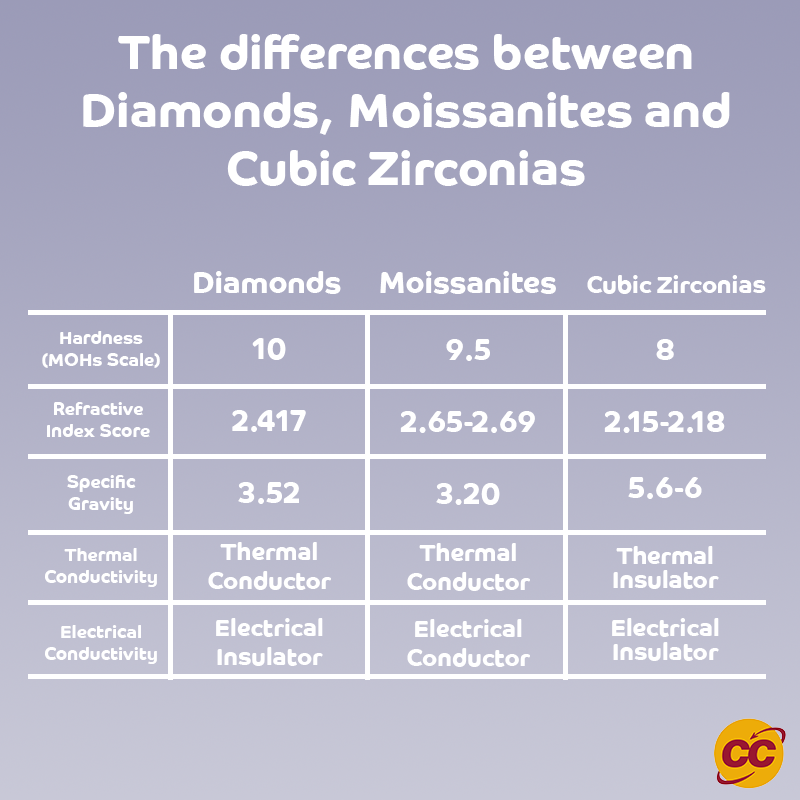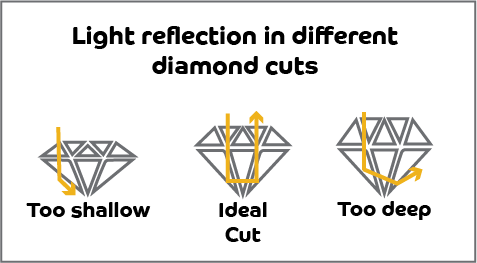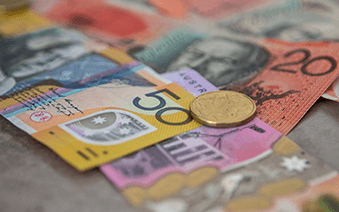You know what they say – diamonds are a girl’s best friend. If you’ve moved from window shopping to the real deal, making a decision on the right stone can be overwhelming.
It can be hard to tell the difference between pieces that look like they have diamonds but are described as ‘moissanite’ or ‘cubic zirconia’.
We can help you spot what a true diamond looks like compared to its alternatives.
Diamonds are what all the imitations aspire to be. It’s a rare naturally occurring mineral made from carbon connected by a very strong chemical bond. This tight bond makes it one of the strongest and most durable substances in the world – these guys can take up to three million years to form on Earth.
You can find diamonds across the globe from Cartier to Cash Converters.
Moissanites look like the real deal. However, unlike a real diamond, natural moissanite is made from silicon carbide. As this naturally occurring mineral is extremely rare today it’s near impossible to find a true moissanite diamond in the market.
You will, however, find moissanite engagement rings – they would just be grown and produced artificially in labs. That’s why they’re sold at a much lower price. A moissanite’s affordability and imitation makes it a good alternative to diamonds.
Yes, they’re strong long-lasting gemstones. Moissanites are often referred to as gemstones born from the stars.
The main differences between the three types of moissanite are colour grade and price. Forever Brilliant moissanite is in the near-colourless G-H-I range, and Forever Classic moissanite is in the J-K range. Forever Brilliant Moissanite is certified by Charles and Colvard, the first manufacturer of moissanite, and comes with a Limited Lifetime Warranty.
No, they don’t lose their shine – you just have to make sure it’s kept clean.
Cubic zirconia (CZ) is a man-made gemstone. They’re made from synthesised material that comes from zirconium dioxide (not to be confused with the precious gem zircon) and are completely manufactured in a lab, made to shine like a real diamond.
A key difference for why synthetic diamonds aren’t the same as CZ is because even man-made diamonds are made with carbon atoms. CZ stones are made to look like diamonds.
Zircon is made of zirconium silicate, and CZ is made of zirconium oxide. They can be hard to differentiate from each other and are confused as being the same as they look like a diamond.
CZ is man-made in labs, and zircon is a natural gemstone. Because zircon is natural and rare, it’s more expensive than CZ and not as hard on the Mohs scale.
It’s a real man-made stone. There are also different zirconias such as the Swarovski Zirconia, which has a 57-facet pure brilliance cut and a meticulous approach to its construction making it almost as durable as a diamond.
Yes, and some have a brilliance that can sparkle more than a diamond. However, real diamonds will always have that true shine.
A few ways. There are a variety of factors that can be used to differentiate between diamonds, moissanite and cubic zirconia. This includes the hardness of the stone, its specific gravity, the way the stone refracts light (refractive index), its colour, and thermal conductivity.
On the Mohs scale of mineral, the higher the score, the harder the item. Diamonds sit at the highest score which places them as one of the strongest stones. Although 10 is the highest score, anything higher than 7 is considered quite ‘hard’ and therefore makes for a durable piece of jewellery for years to come.
If you’re unsure whether your preferred stone comes with the hardness quality, it’s always good to refer to the scale of minerals chart.
Of the three, moissanite actually sparkles the most. Even if it’s stated that the moissanite is ‘colourless’, they’ll always have a grey to yellow tint that makes it easier to tell. When moissanite sparkles, it replicates more of a disco ball.
Cubic zirconia, on the other hand, is made to be completely colourless. It’s only the intense display of light on the stone that can make it more brilliant than a real diamond – but it still doesn’t take away the shine of a real diamond.
Basically, a high refractive index score means the gemstone allows the light to bend when entering the stone and redirects that light back into your eyes.
We see refractive light every day, like through a glass jar or a fishbowl where the light-bending can make an item appear smaller or larger than its true size. In the case of a gemstone, the higher the refractive index score, the higher the shine or brilliance of the stone because of its ability to bend light.
Moissanite has a higher refractive index score due to its faceting design, which means it will appear more brilliant than natural diamonds and cubic zirconia. The bigger the moissanite, the more noticeable this quality becomes – so if you’re considering this stone, be prepared for a lot of attention and dazzle.
Moissanites are also 'double refractive' gems which means the light bends twice as it passes through the gem, which is also why they have a higher brilliance compared to diamonds and cubic zirconia.
You can see the double refraction under a 10x loupe, a small magnifying glass used by jewellers and watchmakers. If you look through the crown (top of the diamond) or the pavilion (the V point from where both sides meet) facets of the stone, you can identify a refraction score. However, this usually requires a trained eye to identify, so it’s best you take it to a professional jeweller to help you.

Another thing to note is that the way moissanite is cut can affect how you view the refraction. If you look at moissanite through the table (or flat top) of the stone, you’ll only see a single refraction. Look through the crown facets to identify if the stone has a single or double refraction.
A simple test to identify double refraction is to look at the lines between the facets on the opposite side of the stone. Double refraction makes the lines between the facets of the stone look blurred, whereas the single refraction on the same angle will show a sharp line on the other side.
Another way to identify gemstones is through their specific gravity value, where you measure the density of the stone. That’s why when you put all three stones next to each other, even with the same carat, a 1ct moissanite will appear larger than a 1ct diamond and a 1ct diamond will look significantly larger than a 1ct cubic zirconia.
If you place each stone of the same carat into the water, cubic zirconia will sink to the bottom much faster than a diamond and moissanite.
Diamonds conduct heat extremely well, whereas CZs are thermal insulators. This is how most diamond testers determine whether a stone is a CZ or diamond. As diamonds are made of an intensely strong chemical bond, it makes it practically resistant to high heat temperatures.
You know when you have to look under a dish to see if it’s ‘microwave and oven safe’? If you oven-bake a dish that can’t withstand that kind of heat, it’ll shatter immediately. As diamonds are insanely strong they’ll be resistant to such heat tests.
Moissanites are also thermal conductors. You'll need a specific diamond and moissanite tester (which tests the electrical conductivity of items), otherwise you may get a false positive as a moissanite being a diamond when you use a basic diamond tester that only tests thermal conductivity.
Diamonds do not conduct electricity, therefore using a moissanite tester that tests electrical conductivity will tell a moissanite from a diamond.
At the end of the day, think about what would put a smile on your face regardless of the value of the stone.
It’s true what they say – a diamond is timeless. However, they’re not for everyone. Some prefer subtlety or a stone that reflects their character or personality. We’ve seen sapphires and topazes on the hands of very happy people, so ultimately it really is an ‘each to their own’ situation.
You might want to opt for moissanite or cubic zirconia if budget is your primary concern.
If you need help finding your next statement piece, engagement ring, or wedding ring, our dedicated jewellery experts are more than happy to answer any questions you have about a piece you have your eye on.
You can browse our current selection of second hand diamond rings, diamond earrings and more online. We also sell a variety of moissanite and cubic zirconia pieces that will bring sparkle wherever you go.

Answering your questions about loans and staying savvy

Get more bang for your buck with these handy tips.

Need some advice that’s not about cash? We can help.